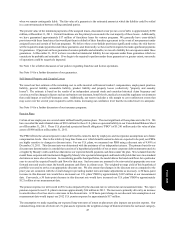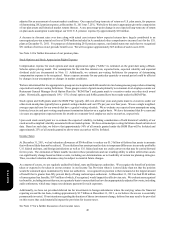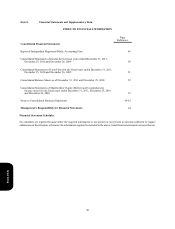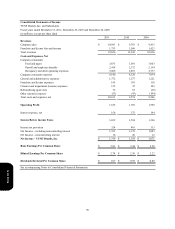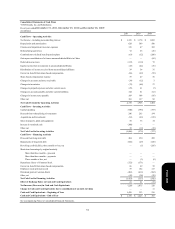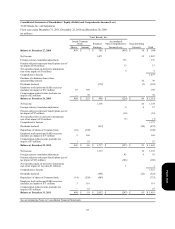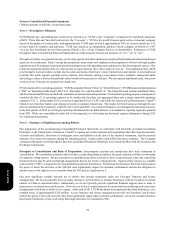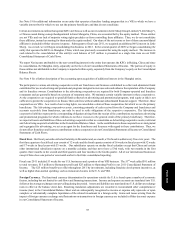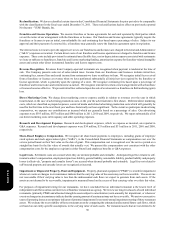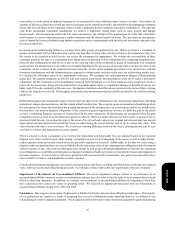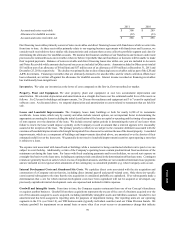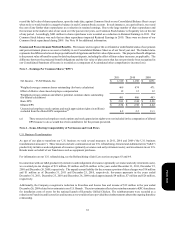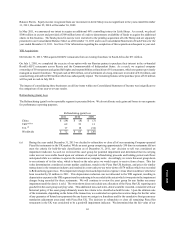Pizza Hut 2011 Annual Report Download - page 159
Download and view the complete annual report
Please find page 159 of the 2011 Pizza Hut annual report below. You can navigate through the pages in the report by either clicking on the pages listed below, or by using the keyword search tool below to find specific information within the annual report.
55
See Note 19 for additional information on an entity that operates a franchise lending program that is a VIE in which we have a
variable interest but for which we are not the primary beneficiary and thus do not consolidate.
Certain investments in entities that operate KFCs in China as well as our investment in Little Sheep Group Limited ("Little Sheep"),
a Chinese casual dining concept headquartered in Inner Mongolia, China, are accounted for by the equity method. These entities
are not VIEs and our lack of majority voting rights precludes us from controlling these affiliates. Thus, we do not consolidate
these affiliates, instead accounting for them under the equity method. Our share of the net income or loss of those unconsolidated
affiliates is included in Other (income) expense. Subsequent to fiscal year 2011, we acquired an additional 66% interest in Little
Sheep. As a result, we will begin consolidating this business in 2012. In the second quarter of 2009 we began consolidating the
entity that operates the KFCs in Shanghai, China, which was previously accounted for using the equity method. The increase in
cash related to the consolidation of this entitiy's cash balance of $17 million is presented as a single line item on our 2009
Consolidated Statement of Cash Flows.
We report Net income attributable to the non-controlling interest in the entity that operates the KFCs in Beijing, China and since
its consolidation, the Shanghai entity, separately on the face of our Consolidated Statements of Income. The portion of equity in
these entities not attributable to the Company is reported within equity, separately from the Company’s equity on the Consolidated
Balance Sheets.
See Note 4 for a further description of the accounting upon acquisition of additional interest in the Shanghai entity.
We participate in various advertising cooperatives with our franchisees and licensees established to collect and administer funds
contributed for use in advertising and promotional programs designed to increase sales and enhance the reputation of the Company
and its franchise owners. Contributions to the advertising cooperatives are required for both Company-operated and franchise
restaurants and are generally based on a percent of restaurant sales. We maintain certain variable interests in these cooperatives.
As the cooperatives are required to spend all funds collected on advertising and promotional programs, total equity at risk is not
sufficient to permit the cooperatives to finance their activities without additional subordinated financial support. Therefore, these
cooperatives are VIEs. As a result of our voting rights, we consolidate certain of these cooperatives for which we are the primary
beneficiary. The Advertising cooperatives assets, consisting primarily of cash received from the Company and franchisees and
accounts receivable from franchisees, can only be used to settle obligations of the respective cooperative. The Advertising
cooperative liabilities represent the corresponding obligation arising from the receipt of the contributions to purchase advertising
and promotional programs for which creditors do not have recourse to the general credit of the primary beneficiary. Therefore,
we report all assets and liabilities of these advertising cooperatives that we consolidate as Advertising cooperative assets, restricted
and Advertising cooperative liabilities in the Consolidated Balance Sheet. As the contributions to these cooperatives are designated
and segregated for advertising, we act as an agent for the franchisees and licensees with regard to these contributions. Thus, we
do not reflect franchisee and licensee contributions to these cooperatives in our Consolidated Statements of Income or Consolidated
Statements of Cash Flows.
Fiscal Year. Our fiscal year ends on the last Saturday in December and, as a result, a 53rd week is added every five or six years. The
first three quarters of each fiscal year consist of 12 weeks and the fourth quarter consists of 16 weeks in fiscal years with 52 weeks
and 17 weeks in fiscal years with 53 weeks. Our subsidiaries operate on similar fiscal calendars except that China and certain
other international subsidiaries operate on a monthly calendar, and thus never have a 53rd week, with two months in the first
quarter, three months in the second and third quarters and four months in the fourth quarter. All of our international businesses
except China close one period or one month earlier to facilitate consolidated reporting.
Fiscal year 2011 included 53 weeks for our U.S. businesses and a portion of our YRI business. The 53rd week added $91 million
to total revenues, $15 million to Restaurant profit and $25 million to Operating Profit in our 2011 Consolidated Statement of
Income. The $25 million benefit was offset throughout 2011 by investments, including franchise development incentives, as
well as higher-than-normal spending, such as restaurant closures in the U.S. and YRI.
Foreign Currency. The functional currency determination for operations outside the U.S. is based upon a number of economic
factors, including but not limited to cash flows and financing transactions. Income and expense accounts are translated into U.S.
dollars at the average exchange rates prevailing during the period. Assets and liabilities are translated into U.S. dollars at exchange
rates in effect at the balance sheet date. Resulting translation adjustments are recorded in Accumulated other comprehensive
income (loss) in the Consolidated Balance Sheet and are subsequently recognized as income or expense only upon sale or upon
complete or substantially complete liquidation of the related investment in a foreign entity. Gains and losses arising from the
impact of foreign currency exchange rate fluctuations on transactions in foreign currency are included in Other (income) expense
in our Consolidated Statement of Income.
Form 10-K


